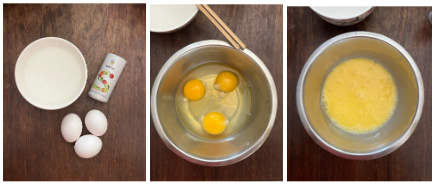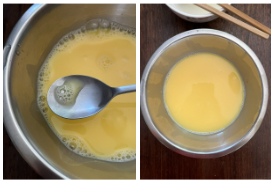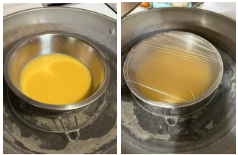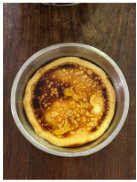Our Taste of Home: Steamed Egg (Zeng Shui Dan: 蒸水蛋)
by Naeomi Chin
Steamed Egg (Zheng Dan: 蒸蛋), or as my family calls it in Cantonese, “zing1 seoi2daan2” (Zeng Shui Dan: 蒸水蛋) is a nostalgic and nourishing dish that I first learned when I was a child. I had to cook for my brother and I during the summers our parents worked during the daytime. My mom taught me this dish as an alternative that I could easily make for the two of us that didn’t involve any pan-frying.
Due to the simplicity of this recipe, my family would occasionally make this dish for dinner if we were limited on time, or if we just wanted a light meal. This is also one of my favorite dishes as it is reminiscent of my grandpa’s version of “egg cooked in rice”, something he always made me when I went over to his house for dinner. Egg with rice was my childhood hyperfixation meal as it was something I would never get tired of. I chose this dish because it represents my nostalgia and my family’s way of expressing their love for us through cooking.
Even now as an adult, I would be incredibly happy whenever my mom made steamed eggs. It has this nice silky texture, similar to tofu when cooked right. It’s also very satisfying when you cut into the dish with a spoon. Once you get the recipe right, it’s just.. chef’s kiss.
Note: This recipe is tailored to our family’s cookware. If this recipe does not work out for you, please do not feel discouraged! It takes a lot of practice and patience to get the consistency of the egg just right.
Recipe:
3 Eggs
Salt
Soy sauce
1-1.5 cups of warm water (key: warm)
A dish that can sustain heat (e.g., stainless steel, ceramics)
The example uses a stainless steel bowl
Optional:
Green onions
Garlic crisps and oil
Preparation:
Take 3 eggs and whisk it until scrambled. Then add a pinch of salt.
2. Boil some water and let it cool until warm. You don’t want the water to be boiling hot because it will begin to cook the eggs. When cooled, pour 1-1.5 cups of warm water. The ratio of water to egg is up to your preference. If you prefer to have a silkier and soft texture, more water. If you prefer to have a more firm and hard texture to your egg, put less water.
3. When the water is poured, make sure to scramble until the egg and water are mixed evenly. Then scrape off all the bubbles on the mixture to the best of your ability. This step is key to keeping the texture of the steamed egg smooth.
4. The next step depends on what cookware you have. My family does not own a traditional steamer, but we use a wok as an alternative. If you don’t have a wok, you can simply use a wide pot as your steamer.
If you don’t regularly use a steamer:
Take a stainless steel round cooling rack and place it in the pot to measure the amount of water you need to create a steamer. The cooling rack is important because you don’t want your egg to be overcooked. It also separates your dish from the hot boiling water.
Next, pour water into the pot, up to the height of the cooling rack.
With high heat, boil the water with the cooling rack
5. When the water is boiling, place your egg mixture on top of the trivet and cover the pot with the lid. Set a timer for 10 minutes and stove fire on medium heat. After 10 minutes, your steamed egg should look nice and firm!
In the image below, my mom uses Saran Wrap to cover the mixture while steaming. This step is entirely optional.
6. The last step is to top it off with soy sauce or any toppings you prefer. My family loves to use green onions and garlic oil and crisps to enhance the flavor of the egg. It helps to add these toppings in case you didn’t add enough salt to the egg during step 1.
That’s it! Enjoy the steamed egg with a hot bowl of rice. It feels like a warm hug on a cold gloomy day.







